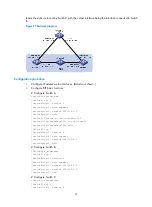
60
The intra-area and inter-area routes describe the network topology of the AS. The external routes describe
routes to external ASs.
OSPF classifies external routes as Type-1 or Type-2. A Type-1 external route has high credibility. The cost
from a router to the destination of the Type-1 external route = the cost from the router to the corresponding
ASBR + the cost from the ASBR to the destination of the external route.
A Type-2 external route has low credibility, so OSPF considers the cost from the ASBR to the destination
of the Type-2 external route is much greater than the cost from the ASBR to an OSPF internal router. The
cost from the internal router to the destination of the Type-2 external route = the cost from the ASBR to the
destination of the Type-2 external route. If two routes to the same destination have the same cost, OSPF
takes the cost from the router to the ASBR into consideration to determine the best route.
OSPF network classification
OSPF network types
OSPF classifies networks into the following types depending on different link layer protocols:
•
Broadcast
—When the link layer protocol is Ethernet or FDDI, OSPF considers the network type as
broadcast by default. On a broadcast network, hello, LSU, and LSAck packets are multicast to
224.0.0.5 that identifies all OSPF routers or 224.0.0.6 that identifies the DR, and DD packets and
LSR packets are unicast.
•
NBMA (Non-Broadcast Multi-Access)
—When the link layer protocol is Frame Relay, ATM, or X.25,
OSPF considers the network type as NBMA by default. OSPF packets are unicast on a NBMA
network.
•
P2MP (point-to-multipoint)
—By default, OSPF considers no link layer protocol as P2MP, which is a
conversion from other network types such as NBMA. On a P2MP network, OSPF packets are
multicast to 224.0.0.5.
•
P2P (point-to-point)
—When the link layer protocol is PPP or HDLC, OSPF considers the network
type as P2P. On a P2P network, OSPF packets are multicast to 224.0.0.5.
NBMA network configuration guidelines
Typical NBMA networks include ATM and Frame Relay networks.
Because NBMA interfaces cannot broadcast hello packets, you must specify neighbors manually and
configure router priorities for the neighbors.
An NBMA network is fully meshed, which means any two routers in the NBMA network have a direct
virtual circuit for communication. If direct connections are not available between some routers, the
network type of associated interfaces must be configured as P2MP. If such an interface has only one
neighbor, configure its network type as P2P.
The differences between NBMA and P2MP networks are as follows:
•
NBMA networks are fully meshed, non-broadcast, and multi access. P2MP networks are not
required to be fully meshed.
On an NBMA network, you must elect the DR and BDR, while on a P2MP network, DR and BDR are
not available.
•
NBMA is the default network type, but P2MP is a conversion from another network type, such as
NBMA.
•
On a NBMA network, OSPF packets are unicast, and neighbors are manually configured on routers.
On a P2MP network, OSPF packets are multicast.
















































